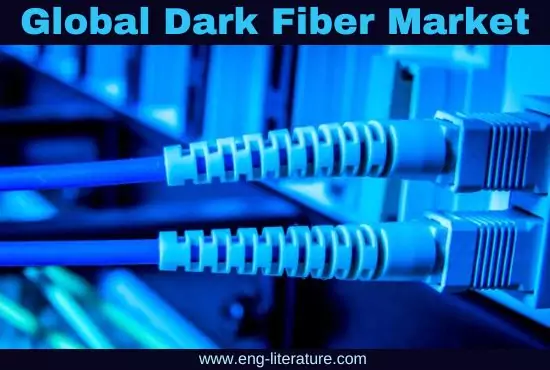Global Dark Fiber Market
Table of Contents
Dark Fiber: Optimizing Communication All Over
You must be familiar with the term dark fiber. Although it may sound gloomy, it signifies a significant opportunity for several enterprise-wide area networks. In the 1980s, when communication firms deployed miles of fiber optic cable underground, their policy was frequently to dig down and bury more fiber than they required at the time. The goal was that if the significant share of the price was linked with underground fiber deployment because of the labor, operations, and equipment required to bury cable, it made a point to deploy extra cable to save money over the coming years when more data transfer and communications capacity would be needed. As the cable was initially deployed underground, the hundreds of miles of unused optical fiber, also called “dark fiber,” has retained excellent capability for internet service providers (ISPs) and telecom companies. It also shows a feasible choice for enterprises and businesses looking for the most excellent means to develop their networks. With the growing demand for feasible communication across the globe, the MRFR analysis reports suggest that the global market for dark fiber will acquire a valuation of USD 9.3billion by the end of 2026. According to these reports, the global market is anticipated to flourish at a robust CAGR of approximately 11.0% during the assessment timeframe.
Dark Fiber: Operation
To take the optimum benefits of these dark fibers, one must understand the working of the dark fibers. Fiber optics cables are made of various strands of glass fibers, tied to a diameter equivalent to that of the human hair transmitting data through the light at a very high speed. Fiber optics technology allows numerous data streams to travel in one fiber- frequently done with a procedure named dense wavelength division multiplexing (DWDM), which can convey various data streams at various wavelengths. Thus, it’s likely for a minor firm to utilize just an intelligent part of the cable’s capacity to convey data in the same cable that a giant firm utilizes for its requirements. This is clearly distinct, though, from how dark fiber is utilized, as we’ll outline below.
Dark Fiber: Use
The world wants high-capacity, reliable connectivity more than ever, and with ISPs managing maximum bandwidth in history, organizations needing larger volumes are frequently discovering themselves investing more & more for premium services or access, like Wave circuits or very high bandwidth point-to-point.
Dark fiber exhibits a substitute. Also known as simply “black” fiber or “unlit”, the cable is literally dark. These cables do not transmit any light pulses through them. For the majority, the dark cables are booked by and owned by big ISPs and telecoms. Still, companies can also benefit from these cables by renting the fibers and “lighting” them with their own network and electronics gear, controlling the network’s speed, security, and architecture. The suppliers of the dark fibers are the “common accused” of enterprise telecoms like Crown Castle, CenturyLink, and Zayo. While renting dark fibers from the supplier, instead of buying some amount of bandwidth over a term, you should rent some strands of fiber over a longer term than the usual ISP contract.
Here are some of the significant applications of the dark fibers:
- In case of high bandwidth requirements
If the bandwidth requirement crosses 1 Gbps currently, dark fiber is the ideal option for you and not the conventional ISPs. Considering the growing bandwidth requirements, which go to double digits in some organizations’ cases, the dark cable is the most cost-effective solution for the firm.
- In case of a secure, personalized, and private network
There are some private network use cases that these fibers can attain better than conventional ISPs. For instance, do you want to install a trading network with the slightest data center link or latency requiring near real-time transmission potential? Using dark fiber, one can build such networks with complete control over security, jitter, speed, and latency.
- In the case of standard WAN
Want to link two buildings with a high bandwidth connection? In the case of a metro city, dark fiber can be a futureproof and attractive choice. The pricing can vary according to the region.
Dark Fiber: Benefits
One of the primary attractions of dark cables is that it enables the user to control the complete network infrastructure nearly. Government organizations and universities frequently use their own network, given the capability of accessing the network and high security. Individual users of dark fiber can adjust and monitor the latency and speed of the network, offering modified control not always available from an ISP.
Another prime advantage of dark fiber is its stability. Depending on commercial telecom or internet services, only accessing applications and infrastructure in the cloud can produce threats; if services are disrupted, employees can’t access the data or services they require. Innovative businesses will always have a backup option and internet access but still, depending on the ISPs. Switching to dark fiber is the best choice in such cases as they lower the chances of outages and boost uptime.
From all the benefits mentioned here, it is clear that dark fiber is not to be taken casually, and they are the current choice for the high bandwidth requirements.

Hello, Viewers! Besides being the Founder and Owner of this website, I am a Government Officer. As a hardcore literary lover, I am pursuing my dream by writing notes and articles related to Literature. Drop me a line anytime, whether it’s about any queries or demands or just to share your well-being. I’d love to hear from you. Thanks for stopping by!

Read More About Dark Fiber Market:
https://www.marketresearchfuture.com/reports/dark-fiber-market-10514